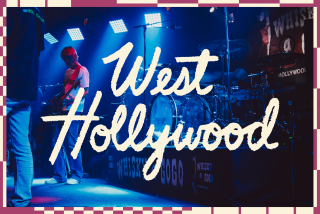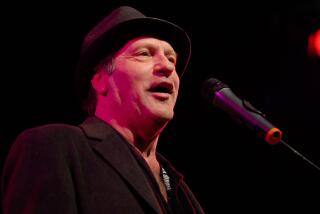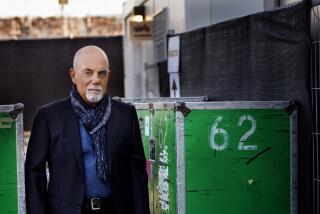KEY WEST--WHERE THEY REALLY REMEMBER PAPA
- Share via
KEY WEST, Fla. — There, in a tiny recording studio, stood the whitest man in America, surrounded by a dozen men and women who were singing the mysterious phrase “Going tropo,” who were clanking bells and generally making merry. With these dozen or so individuals who were wired with, well, enthusiasm, he stood there with his mouth slightly agape (or perhaps slightly aghast): George Plimpton cowering in the middle of this crowded movement, himself immobile, bewildered, bemused like a noble stork surrounded by savages celebrating a pagan feast at which stork meat might or might not be served, the stork is not quite sure.
Was Plimpton thinking, what am I doing here? Or was he thinking, only in Key West? Or was George Plimpton thinking: what would Papa have done?
Plimpton was in Key West for a literary seminar that went by the name of “Hemingway: A Movable Feast” and ran from Jan. 10 to Jan. 13. Tall, patrician, elegant, articulate, Plimpton regaled the opening session’s audience with stories of his adventures with Papa: How Hemingway ordered him to run with the bulls in Pamplona, Spain; the time Papa almost throttled him because Plimpton had asked a seemingly innocent question about symbolism in the master’s work; and then of course there were those occasions when Papa started impromptu boxing matches and slapped George around.
Throughout the official sessions and receptions, Plimpton remained unflaggingly patient and gracious with all the good folks who wanted to shake his hand, get his autograph, chat a moment. But a literary seminar in a party place like Key West does not live by official events alone. There are private get-togethers. There are public adventures. And there was this thing in the recording studio.
The idea was to lay down a track of background sounds for a song called “Tropo,” which refers to the Key West condition of “going tropical” or becoming so enamored of the unruffled style of life here that you do not want to travel north toward home. Largely through the effort of George Murphy, a Key West publisher and houseboat owner and party giver, a background group was assembled (if assembled is what you can call it) and some of the local and visiting literary likes were brought along. Novelist Timothy O’Brien, who received the National Book Award for “Going After Cacciato,” was there. Rust Hills, Esquire magazine’s fiction editor was there. As were others.
Most of these respectable members of the group surveyed the hard core party-goers with benevolence and were game enough to sing out the tropo theme at the appropriate points even if Hills did keep saying, “Going torpo “ instead of “going tropo,” though when you think about it he may have had it right after all. It was Plimpton who seemed most displaced, who looked like the quintessential gentleman who somehow has found himself commandeered into a conga line.
What would Papa have done?
The direction of your speculation on that question depends upon which Hemingway image you chose to believe in. Was he (a) a drunken bully who might have duped his way out of the studio silliness or was he (b) basically a gentle and shy man who would have endured the scene and still retained his dignity much as Plimpton did?
The correct answer according to the Key West seminar is (b). This was a gathering of fans assembled to hear and tell the old legends and stories we’ve all heard and told so often but not so often we can’t tell them one more time.
Sponsored by the Council for Florida Libraries, funded by a variety of local and national agencies and moderated by Miami Herald book editor William Robertson, the Movable Feast gathering was the third in an annual series of seminars that likely are to get bigger and rowdier as the word spreads and the word is: Only in Key West.
The town is located on a flat coral island stuck 100 miles out into the ocean off the tip of Florida, a place as far laid back as it is south. It’s the southernmost spot in the continental United States, closer to Cuba than to Miami.
Key West strolls along in a wide arc of possibilities: tourist trap, authentic fishing port, artist colony and the kind of town that shrugs at or doesn’t even notice certain activities that the Bible and several Southern states prohibit. Key West has a large and an active homosexual community. One hears that some residents routinely use kinds of pharmaceuticals Rexall doesn’t dispense. A former mayor once water-skied to Cuba.
So of course there were fireworks and Hemingway look-alike contests at the local famous bar where the famous writer drank famously. A People magazine writer and photographer fit right in.
The serious business of the seminar, meanwhile, was conducted by the academic experts who are analyzing Hemingway line by line and who are chronicling his life even unto the point of photographing the shrubs around the house he lived in. Serious business also was conducted by serious writers like O’Brien, who explained Hemingway’s influence on him as a writer and as a writer about war. And personal recollections were offered by George Plimpton and Patrick Hemingway, the second of E.H.’s three sons.
But, hey, this is Key West where seriousness lasts as long as bad moods and foul weather. This is the place where, upon driving into the old section, the first commercial establishment that catches your eye is the Margaret-Truman Drop-off Launderette. So casual is the local mood that when a resident decided to leave the seminar, he came upon the stage in the middle of the O’Brien panel discussion and in front of a 300-plus audience to retrieve a ballpoint pencil a panel member had borrowed.
If this country has a Hemingway industry--and it does--then the Key West seminar was the annual meeting at Headquarters South. The news is good: stocks are high, literary reputations have been retooled and business is booming. For an unabashed Hemingway fan, Key West is a delight (though at times an unsettling one) because probably no other town in America has embraced a writer so joyously, completely, foolishly and commercially as Key West has Hemingway.
The writer owned his Whitehead Street house for 30 years, from 1931 to his death in 1961, and wrote the majority of his books in Key West. Many of his fishing expeditions and drinking exploits were launched from and in Key West. The legends might not be completely true but they are well known and to recount where they occurred is a kick.
Sloppy Joe’s was Hemingway’s favorite hangout and today the bar has become something of a commercial shrine to Papa, with scores of photographs and memorabilia, some of which you can buy at the little stand in the corner.
The Whitehead house is a privately owned tourist attraction that you can tour for $2.50 plus whatever tip you choose to give the guide (and you can be fairly confident that tips will be accepted because the guide begins the tour with several crisply folded dollar bills sticking out of his coat pocket).
This man alone is worth the trip. He is a trip. A delightful and theatrical imp, he wore a black shirt, blue coat and enough gold chains and pendants to dazzle you almost as much as did his honey-smooth Southern accent. “Come along, little pilgrims,” he called as he danced from room to room, and you wonder if he has come to this job fresh from doing Truman Capote tours. But of course he is perfectly attuned to where he is. Only in Key West.
Maybe George Plimpton should stop worrying and allow himself to shout “Going Tropo” because maybe Papa would not have minded terribly what they’re doing to him in Key West. A young aspiring writer by the name of Arnold Samuelson came to Key West in 1934 to meet the master. Hemingway took the kid in, gave him a job and answered generously Samuelson’s innocently direct questions about writing.
The crowd coming to Key West for this seminar 50 years later was more library-literary than writer-literary and the receptions were more elegantly sedate than they might have been if Papa was in attendance. But these middle-aged men and women in their expensive suits and careful dresses are paying homage to Hemingway as much as did the young Samuelson who hitchhiked from Minnesota and hopped a freight train to Key West, arriving busted and covered with soot. Fans all.
Let the bad news about Hemingway books that don’t work and personal bulliness be told elsewhere, because this was a celebration of which the object of celebration might have approved.
Ernest Miller Hemingway was a tad under six feet in height. At the Hemingway house, the tour guide informs us that the master of the house was 6 feet, 3 inches tall and so there you have it all: not only is his reputation growing, Papa actually is getting taller. Only in Key West.
More to Read
Sign up for our Book Club newsletter
Get the latest news, events and more from the Los Angeles Times Book Club, and help us get L.A. reading and talking.
You may occasionally receive promotional content from the Los Angeles Times.






